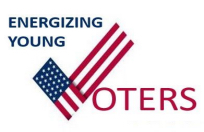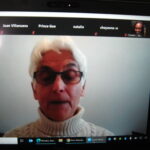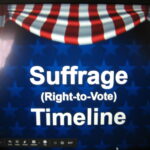by eyv_admin | Oct 28, 2021 | news
By TAPinto Plainfield Staff
PLAINFIELD, NJ – The 2021 midterm elections are fast approaching, and a group of Plainfield High School students want to motivate voters to exercise their right to vote.
The students have been discussing the power of the vote in their social studies classes, and the many sacrifices throughout the history of this country that people have made to be able to vote. This is the second forum the students will lead to motivate voters to cast their vote in the General Election on November 2.
The first program was held October 4, discussing how to vote early. The students worked in partnership with the League of Women Voters (LWV). Dr. Patricia Supplee, Director of the LWV Energizing Young Voters program, trained the students and assisted them with their presentations.
On Monday, November 1, the students will discuss the history of people in the United States who have been excluded from voting. They will review information about the location of voting polls, procedures on how to cast your vote and what to do should you have trouble voting on Election Day.
Dr. Tristian Cox, K-12 Social Studies Supervisor for Plainfield Schools, said, “The goal of the program is to provide information to community members who might need it. The program will be student- led, which supports the second goal in developing student leaders to take ownership of their learning process.”
Plainfield High School student presenters include Zayin Joshua Jagmohan, Zayin Roberts, Amanda Green, Milena Guerra, Nathalie M. Sipaque, and Ky’ere Fleming.
The presentation will be held Monday, November 1 at 7:30 p.m. To join,
click on the Zoom link here. The link is also posted on the district website.
by eyv_admin | Oct 24, 2021 | news
“I do love a locker room. It smells like potential.”
— Coach Ted Lasso (the beloved protagonist of Apple TV’s latest breakout hit)
Ted Lasso’s rapid ascent and positive infusion into our cultural zeitgeist solidified something I already knew: That coaches are an often unsung force for good, and we ought to be doing more to recognize their unique power and influence in positively shaping lives.
As a former collegiate athlete, I’ve long known the power of coaches, but my current enthusiasm is tied to a more recent journey of discovery and transformation alongside my own personal Ted Lasso, my friend and colleague Eric Reveno, who coaches the men’s basketball team at Georgia Tech.
Like Lasso, Coach Rev looks at a locker room and sees potential in his players — not just as competitors, but as compassionate, caring and capable community members and community leaders. In the past year, Coach Rev added a new element to his coaching focus: civics.
In June 2020, following the murder of George Floyd and the public outcry for social justice reform, Coach Rev embarked on a personal mission to help his players register to vote. But his efforts didn’t end with his own team. Coach Rev became the driving force behind #AllVoteNoPlay, an initiative that urged athletics to take election day off from practice or games so players could vote and volunteer. With support from the National Association of Basketball Coaches and the ALL IN Campus Democracy Challenge, over 1,100 coaches ultimately signed the #AllVoteNoPlay pledge. The call to action was so meaningful to players that the student-run NCAA Student Athletic Committee leadership team unanimously passed legislation to make #AllVoteNoPlay an annual tradition.
Coach Rev and I met last year while I was working on my own personal mission to change the way we engage young people in the voting process. I saw a future marred by an increasingly divisive, expensive and alienating political process that didn’t support a healthy, robust democracy. As a designer, educator and futurist, I was curious how practices of design, empathy, and imagination might transform the experience of voting. Together with colleagues, I created Vote by Design, a program focused on turning “apathy” into civic agency through experiential learning and practice. Our aim is to help young voters develop the confidence and capacity to approach voting as a lifelong skill that could be nurtured through intentional practice. Seeking ways to support his new #AllVoteNoPlay initiative, Rev brought Vote by Design to his students. We instantly bonded in our shared belief that young people need and deserve to be not just informed, but empowered to participate more fully in shaping the future they’re going to inherit.
2020 itself was a singular moment in time, and when the immediacy of a highly charged presidential election cycle faded, a new set of questions emerged: How do we ensure that young people continue to learn and engage in our democracy? Who can help them understand their central role in shaping the future? Who, in the lives of young people, holds the position of trust and mentorship to deliver the necessary messages about civic participation without being dismissed as “boring”, “preachy” or what “others do.”
The answer is clear. As Rev said to me: “It’s time for coaches to teach civics.”
The need to educate young people about their personal power and agency in every moment of civic life — from helping a neighbor, to voting for town council, to casting that biggest of all ballots every four years. Research shows that civic awareness and engagement not only help young people find their voice in their own communities, but also increase their success and satisfaction in life. Civically empowered and educated youth are more likely to finish their education, are better prepared for future careers, show greater empathy and tolerance for differing viewpoints, and are more likely to give back to their communities through volunteerism later in life. And the students themselves are asking for more voice and action, as evidenced by the 75 percent of NCAA-surveyed athletes who expressed interest in more civic engagement.
But these outcomes don’t just happen. The research tells us they’re created through practice and active learning. Tufts University’s Center for Information and Research on Civic Engagement calls it a posture of “growing voters.” And that’s where coaches come back into play. Who knows more about setting up intentional practice to build core muscles and develop necessary skills than coaches?
Coach Rev and I have spent the past several months working to create the practice plan that will help coaches translate their skills as natural leaders in the locker room, to natural leaders in civic engagement. Our work is based on the belief that “civic conditioning” can be just as powerful as “strength conditioning.”
This year, when #AllVoteNoPlay comes around on Nov. 2, we’re ready to help coaches across the country turn the day off from sports into a day on for civic practice.
Working closely with a community of coaches, student-athletes and some of the best minds in the civic learning space, we’ve created the #AllVoteNoPlay Coaches’ Playbook, a nonpartisan, hands-on approach to “civic conditioning” for Nov. 2 and beyond.
According to Rev, “Drills are where the magic happens.” Our vision for #AllVoteNoPlay is not to recreate traditional civics classes, but instead to offer simple, accessible, meaningful “civic drills” that inspire coaches and athletes to learn, engage and gather for community-building experiences. Our aim is to ignite the confidence within athletes that they — as individuals and as teammates — have a voice, choices, the agency to act and the power to make an impact in moments both small and large.
So this Nov. 2, we’re spreading those messages across the entire NCAA. Every coach, every team, regardless of sport or division, can take part in #AllVoteNoPlay. It’s as easy as choosing a civic drill and trying it with your team. Gathering for a team barbecue and movie night, taking an online quiz or engaging in a game of “civic tag” may not seem like a life-changing effort, but Rev and I believe in the power of these micromoments to start building the civic muscles athletes will need for a lifetime of good citizenship and community leadership.
We look at a locker room and see potential.
And I hope that this is just the first of many #AllVoteNoPlay Days ON, rather than days OFF, where coaches seize their moment and realize that potential.
by Lisa Kay Solomon, who is on the faculty of Stanford University’s design school and a creator of Vote by Design, an educational site designed to promote civic and political engagement among younger voters.
by eyv_admin | Sep 7, 2021 | news
By David Wronko, history teacher at Dr. Martin Luther King Jr. Middle School (formerly Asbury Park Middle School).
This past year I had the opportunity to work with Patricia L. Supplee and the League of Women Voters to bring interactive lessons to my remote classes. In addition, the League of Women Voters were able to bring their program remotely to Oiada International’s Project Ghana (Here is the link to that article: THE LEAGUE OF WOMEN VOTERS MEET THE STUDENTS OF THE SOLID ROCK FOUNDATION SCHOOL IN GHANA AND MORE! | Unheard Voices Magazine).
The purpose of this remote session was to learn how to take multiple approaches into engaging students in their studies with history and civics.
Krysten Semerano and Allison Connolly, Ocean Township High School teachers, were the lead teachers who demonstrated these approaches during this remote meeting. Under the topic of study in which they were presenting these methods of teaching, “Martin Luther King and the Struggle for Voting Rights,” Semerano and Connolly had the audience engage in topics about how the south was set up after the time of the American Civil War. For instance, discussion on Jim Crow and Disenfranchisement, why segregation still existed after the passage of the 14th and 15th amendment, and Plessy vs. Ferguson took place. From there a critical thinking question was introduced to elicit response as a teacher would do in the classroom.
For example, in 1909, the NAACP decided on a legal strategy to fight segregation, why did they decide on this strategy and would you be optimistic or pessimistic about this strategy?
From there the remote lesson tackled Martin Luther King Jr.’s effort of deciding whether or not to march over Pettus Bridge. The presenters had a template which gave the opportunity to those joining remotely, as a teacher would do with students in the classroom, to take two directions of whether or not crossing the bridge could happen. Those who attended, students would do this method in the classroom, had to pretend that they were Dr. King and decide yes and why they would cross or go in the other direction of being Dr. King and decide no why they would not cross.
I felt this remote session that was sponsored by the League of Women voters to be very insightful as I gained knowledge of ways to present this important topic to my students in the upcoming school year.
Original article here.
by eyv_admin | Mar 21, 2021 | news
Through my supervisor, Ms. Janice Kroposky, I had the privilege of recently having the League of Women Voters conduct a presentation for my 7th grade advanced social studies class. The presenters Patricia Supplee, Luisa Paster, Agnes Roche, and Beth Andrea Stevens, created an interactive lesson that brought my students through a suffrage timeline. To begin with, my students were assigned an avatar. Every avatar had a person with different characteristics from each other. From there, my students had the job to decide during the League’s presentation when they believe their person belonged in that part of history that was being shown. Since we were remote learning, they accomplished this by first beginning with their icons on. Then when they thought their person belonged in that time in history, my students would turn off their icon to reveal their face.
Through my supervisor, Ms. Janice Kroposky, I had the privilege of recently having the League of Women Voters conduct a presentation for my 7th grade advanced social studies class. The presenters Patricia Supplee, Luisa Paster, Agnes Roche, and Beth Andrea Stevens, created an interactive lesson that brought my students through a suffrage timeline. To begin with, my students were assigned an avatar. Every avatar had a person with different characteristics from each other. From there, my students had the job to decide during the League’s presentation when they believe their person belonged in that part of history that was being shown. Since we were remote learning, they accomplished this by first beginning with their icons on. Then when they thought their person belonged in that time in history, my students would turn off their icon to reveal their face.
The League’s presentation went into many areas in history. It began with the meaning of the word suffrage (right to vote). Then why was it important that we vote. The presentation showed that everyone should vote and that all elections were important. It was important that people vote in all elections from the presidency, to members in congress, and to the governor of our state so that everyone would be properly represented. Ideas on why people vote was shown. Here was that list:
Environment
Immigration
International Relations
Social Justice
Education
Taxes
Covid 19
Stop gun violence
From there, the presentation went into the time of the American Revolution. It was mentioned that Great Britain saw voting as opposing the crown. However, after the American Revolution the Founding Fathers had to design the rules for voting and this took place around 1789. The timeline presentation then went into who was eligible to vote during the American Civil War, the 19th Amendment (which gave women the right to vote), the 15th Amendment being challenged by the Jim Crow Laws, the importance of the Voting Rights Act of 1965, and the 26th Amendment during the Vietnam war which lowered the voting age to 18. Furthermore, besides African Americans and women, the Suffrage presentation went into the hardships that many other groups went through trying to gain their right to vote. Those groups were Asian and Native Americans.
In closing my supervisor and myself would like to thank the League of Women Voters for giving our 7th-graders a hands-on civics lesson and walk through history about the struggle of people to gain the right to vote.
Original article here.
by Geeks on the Beach | Mar 1, 2021 | news
Shortly after the Inauguration on January 20, 2021, Lisa Kay Solomon, the developer of one of our teaching modules (Vote by Design,) wrote an article in www.thefulcrum.us. Solomon says,
Amanda Gorman is “a civic futurist.” Gorman says: “We lift our gazes not to what stands between us, but what stands before us…” As Gorman declared at the inaugural: “Somehow, we’ve weathered and witnessed a nation that isn’t broken, but simply unfinished.”
Simply unfinished. That’s the call. That’s our charge… a futurist says, “I will boldly imagine what can be.”
THAT’s what Energizing Young Voters is all about. Boldly imagining what can be…
What we have seen when working with students are young people who are passionate about issues that face our nation, states, communities and schools. These students are far from apathetic about the world in which we live. What is lacking is not concern, passion, idealism, or willingness to work hard. What is lacking is an understanding of how to be engaged civically… the how-to’s, the nitty-gritty of being a lifelong voter and involved citizen.
What we have seen when working with students are young people who simply don’t yet realize how much impact they might have. They do not yet understand that if they exercise their collective right to vote and engage in civic action, they can bring about the change they want to see. It can happen – they can make it happen. There is individual and collective power to make a difference for the greater good.
Real, lasting change comes from more than just civic knowledge – from facts about things like the balance of powers or the branches of government. Granted, it is important to know those things, but textbook facts are not going to bring about real, lasting change. Change comes about from the application of knowledge — from civic engagement and agency — knowing what actions can be taken and how, when, and where to take those actions, and by developing the skills and confidence needed to make it so.
Energizing Young Voters believes this is a moment to reframe civics as a mindset, not an academic course. Experiences and opportunities for young people to become active citizens are needed now. Our commitment is to continue to engage students in moving us towards the “more perfect union” that was envisioned in our Constitution. As Lisa Kay Solomon says:
If we think of our nation as unfinished rather than broken, and actively teach our [upcoming] generation of citizens to imagine a finished nation, we embrace a growth mindset and open up a world of possibilities to collectively write the next chapter of the story.
THAT’s what Energizing Young Voters is all about.



